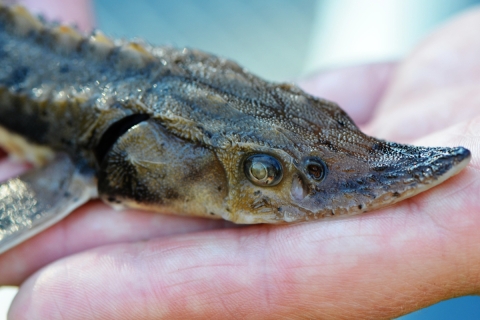In spring of 2021, the Alpena Fish and Wildlife Conservation Office began a lake sturgeon habitat mapping project on the Cuyahoga River, Ohio, in collaboration with the Ohio Department of Natural Resources, Cuyahoga Valley National Parks Service, and other partners.
The river historically supported a spawning population of lake sturgeon but impacts from pollution and habitat fragmentation likely led to the loss of spawning runs circa 1850 and extirpation from the river. However, water quality has improved following the signing of the Great Lakes Water Quality Agreement in 1972 and removal of the Brecksville Dam in 2020 resulted in an approximately 45 mile stretch of river without a man-made barrier, from Lake Erie to the Ohio Edison Dam near Akron, Ohio. Given historic use by lake sturgeon, improvements in water quality, and removal of man-made barriers, the Cuyahoga River is a candidate system for lake sturgeon reintroduction, contingent upon availability of water depths, water velocities, and substrates suitable for spawning adults and development of age-0 (young-of-year) sturgeon.
Alpena is working with partners to map substrate types and channel bathymetry to quantify the amount of suitable habitat for spawning adults (rocky areas with moderate water velocity and depths) and age-0 fish (sandy and silty areas with low water velocities). Side-scan sonar is being used to map substrates throughout the 45 mile stretch from Lake Erie to the Ohio Edison Dam and the river will be revisited during low flow to ground truth sonar images with visual surveys. Channel bathymetry will also be collected and used to develop a flow model to estimate the availability of suitable water depths and velocities for multiple discharges. This project is the first step to assessing the possibility of lake sturgeon reintroduction in the Cuyahoga River and will help determine if the river can support lake sturgeon reproduction and age-0 fish.




